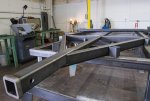Would love to get some feedback on the design below.
Constructed with 2" steel tubing, 1/8" wall everywhere except the tongue, which would be 2.5", 1/4" wall.
Overall plan will be a pretty fully loaded expedition trailer, 40 gallon water tank, RTT, kitchen, batteries, etc.
Right now Timbren 3500 axles is the plan, but would love to make a custom independent suspension, but that seems like to big a bite to chew right now. There's always gen 2, right?!
My main areas for comment are:
1. Tongue length and overall construction of the frame.
2. How to predict where to put the axle line without fully mocking it up with weights. Is there a general rule of thumb? I kinda eye balled it based on commercial offerings.
3. How to predict ride height with the timbren. Plan is to have it be on matching 285 70 17 tires.

Rough mock up of the body

Tow rig 2015 Land Cruiser

Constructed with 2" steel tubing, 1/8" wall everywhere except the tongue, which would be 2.5", 1/4" wall.
Overall plan will be a pretty fully loaded expedition trailer, 40 gallon water tank, RTT, kitchen, batteries, etc.
Right now Timbren 3500 axles is the plan, but would love to make a custom independent suspension, but that seems like to big a bite to chew right now. There's always gen 2, right?!
My main areas for comment are:
1. Tongue length and overall construction of the frame.
2. How to predict where to put the axle line without fully mocking it up with weights. Is there a general rule of thumb? I kinda eye balled it based on commercial offerings.
3. How to predict ride height with the timbren. Plan is to have it be on matching 285 70 17 tires.

Rough mock up of the body

Tow rig 2015 Land Cruiser


